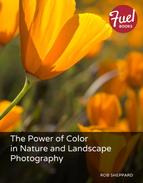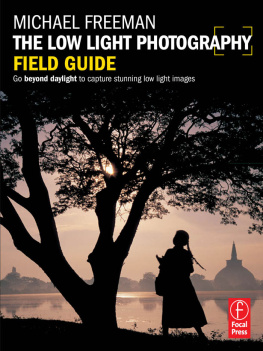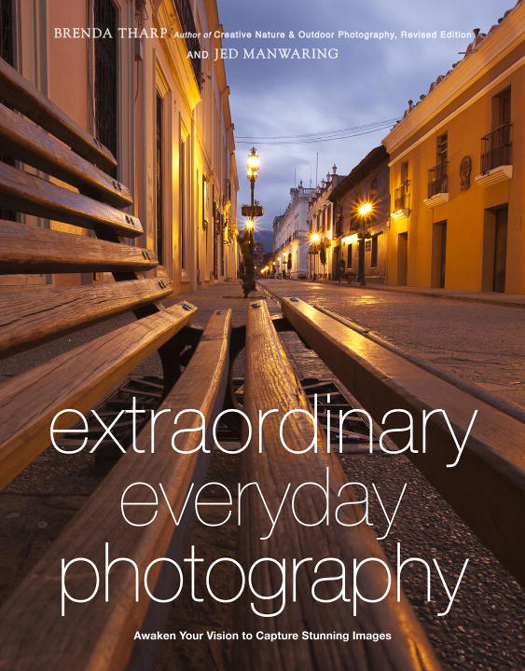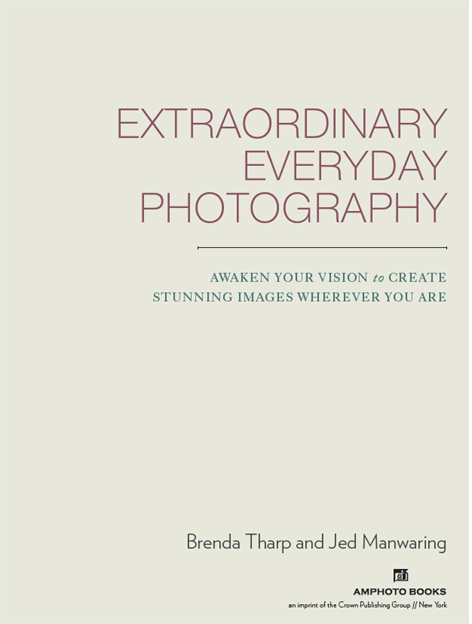
Copyright 2012 by Brenda Tharp and Jed Manwaring
All rights reserved.
Published in the United States by Amphoto Books, an imprint of the Crown Publishing Group, a division of Random House, Inc., New York
www.crownpublishing.com
www.amphotobooks.com
AMPHOTO BOOKS and the Amphoto Books logo are trademarks of Random House, Inc.
Library of Congress Cataloging-in-Publication Data
Tharp, Brenda.
Extraordinary everyday photography: awaken your vision to create stunning images wherever you are / by Brenda Tharp and Jed Manwaring. 1st ed.
p. cm.
Includes bibliographical references and index.
1. Outdoor photographyAmateurs manuals. 2.
PhotographyTechniqueAmateurs manuals. I. Manwaring, Jed. II. Title.
TR659.5.T46 2011
778.71dc23
2011040810
eISBN: 978-0-8174-3594-3
Cover design: La Tricia Watford
Cover photographs: Brenda Tharp and Jed Manwaring
Interior design: Kara Plikaitis
Design by Kara Plikaitis
v3.1
To all those who have inspired us to see more deeply that which was right in front of us, and to each other for mutual support in the dance of life
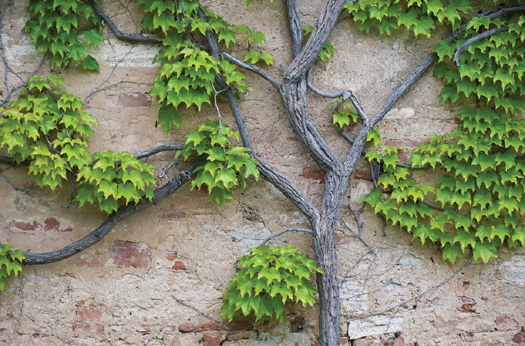
Contents
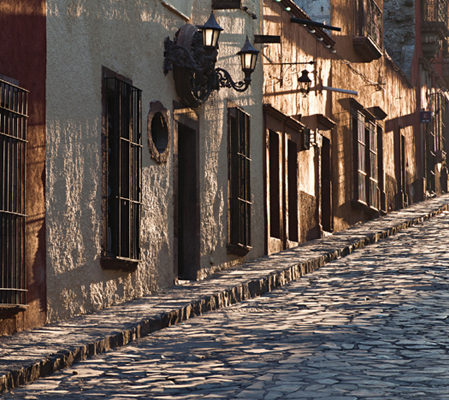
CHAPTER 1:
Finding Fresh Vision
CHAPTER 2:
The Moment of Perception
CHAPTER 3:
Discovering Pictures Where You Live
CHAPTER 4:
Expanding the Creative Process
CHAPTER 5:
Capturing Everyday Moments
CHAPTER 6:
Finding Your Point of View
CHAPTER 7:
Creating Strong Compositions
CHAPTER 8:
Exploring the Light Around You
CHAPTER 9:
Photographing at Dusk and Dawn
CHAPTER 10:
Photographing the Night Around You
Introduction
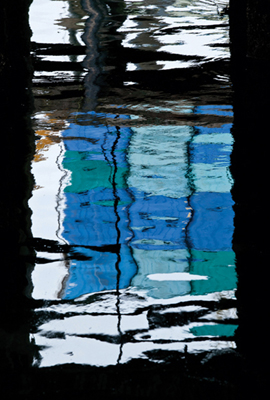
B: 70200mm lens at 200mm, f/9 for 1/80 sec.
P HOTOGRAPHERS ARE A TRAVELING bunch. We go places to capture the light, the landscape, the wildlife, and the people. Many photographers travel quite a distance to make their pictures, seeking out exotic locations. But do we have to go far to find interesting things to photograph? Some of you would answer with a resounding Yes!, and for certain types of photographywild animals, unique cultures, and so onyou would be right. However, wonderful images are hiding almost anywhere, if you just look. We are willing to bet that you can make great photographs near where you live, no matter where that is.
There are many books on the basics of photography and digital technique, but few that write about using the heart along with the mind to make great pictures. Almost anyone can master the basic skills with todays digital cameras, but will those images have meaning? Photography isnt just about the mechanics of setting aperture and shutter speed, and pressing the shutter release. Its also about figuring out what youre trying to express in your picture, and when to press the shutter button. To do this we must have a creative vision that comes from seeing with an open heart and mind. We opened a Chinese fortune cookie while working on this book, and the fortune inside couldnt have been more perfect! It said, We see with our heart and not with our eyes. Was that a sign?
We got the idea for this book after talking with a dear friend. As an amateur photographer with a never-ending passion for developing her creative vision, she told us that many more pictures in her camera club competitions were from faraway places than the areas around home. She admitted that she, too, had traveled a great deal, and to fairly exotic locations, to photograph. Yet she had come to realize that she wasnt experiencing her own culture, her own exotic location, as much. She decided to change that by exploring her local neighborhood, and she began to see things she hadnt seen before: the way the wisteria draped over the park fence in springtime, the tree shadows that the afternoon sun created on the wall of the grocery store. She made playdates with herself and photography friends to go someplace each week, within reasonable proximity to home, to see what they could find. She was seeing photographs everywhere and having fun, and her photographs were different and fresh.
What had changed? She was the same person, with the same physical vision. Yet she had begun to look past a lamppost as being just a lamppost, and instead saw its shape, or its shadow on a wall. She didnt care if her picture was of a bench; it was the way it looked in the sidelight or the color contrast of it against a painted wall. It was not the thing itself but what light and geometry had made it become that interested her. This is a true story, and it resonated with us as we talked. And thats what got us started on this book. In addition, we each had our own personal reasons for wanting to write about creative vision.
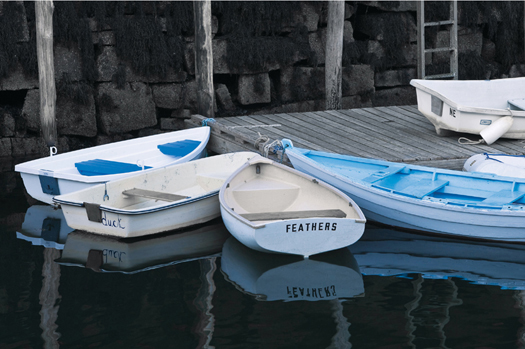
B:70200mm lens at 150mm, f/8 for 1/30 sec.
Please Note:
Throughout this book, our images will be identified with a B for Brenda, or a J for Jed.
BRENDA
My dad had a strong work ethic. He was always busy with some project. Its something I inherited and perfectedperhaps to a fault! While Im thinking of the next task I have to get done, or planning where Im going to photograph, Jed is looking at the shadow his cereal bowl and coffee cup make on the table. Hes always had the ability to lose himself in the moment while seeing something wonderful right in front of him. Ive learned how to do this more from him. Yet while my dad may have been a bit structured, he and my mom were the reasons I got started in photography. Our camping trips and explorations involved long car trips, and a game wed play to keep busy was a half-penny for the first one to spot a brown cow, or a gray barn. It was a great way to get us really looking at everything we passed. That habit continues today. Instead of reading magazines or doing work on my laptop when Im traveling, Im looking out the window and enjoying the beauty. Photography allows me to share my feelings of Look at that! with others.
JED
When I was young, I used to help my grandmother put together her travel slideshows. I would often ask, Why did you take that picture? She would smile and tell me that it was needed to tell the story of where they had been. But occasionally she would just say, Yes, isnt it a wonderful image? And I had to admit that it was. Although I didnt understand why, I liked it. It touched something inside of me that I couldnt express in words. Now, as I pursue my own photography, I have always tried to keep that connection to things I see, to react almost instinctively to an image and then, only after I have recorded it, to fine-tune the technicalities. When I picked my favorite of her images, my grandmother would often reply, I like that one, too; you have a good eye. True or not, this was an affirmation of the way I saw things and it encouraged me to continue developing my personal vision. As a kid, I traveled with my family around the West, seeing wondrous things, and my father and mother always encouraged me to explore and gave me cameras to record what I discovered. It was the basis for my choosing a career in photography and teaching others to discover beauty, too.


